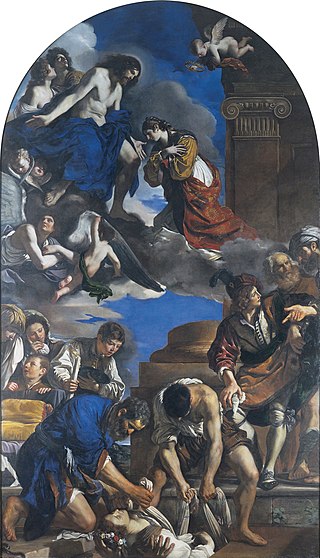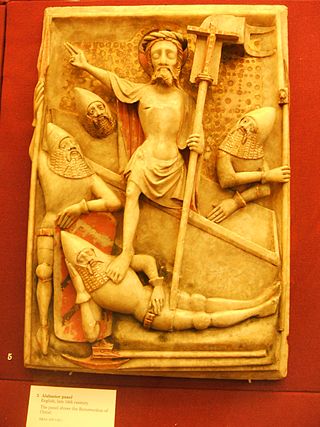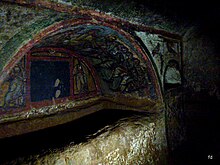
The Catacombs of Rome are ancient catacombs, underground burial places in and around Rome, of which there are at least forty, some rediscovered only in recent decades.

Early Christian art and architecture is the art produced by Christians, or under Christian patronage, from the earliest period of Christianity to, depending on the definition, sometime between 260 and 525. In practice, identifiably Christian art only survives from the 2nd century onwards. After 550, Christian art is classified as Byzantine, or according to region.

Saint Peter's tomb is a site under St. Peter's Basilica that includes several graves and a structure said by Vatican authorities to have been built to memorialize the location of Saint Peter's grave. St. Peter's tomb is alleged near the west end of a complex of mausoleums, the Vatican Necropolis, that date between about AD 130 and AD 300. The complex was partially torn down and filled with earth to provide a foundation for the building of the first St. Peter's Basilica during the reign of Constantine I in about AD 330. Though many bones have been found at the site of the 2nd-century shrine, as the result of two campaigns of archaeological excavation, Pope Pius XII stated in December 1950 that none could be confirmed to be Saint Peter's with absolute certainty. Following the discovery of bones that had been transferred from a second tomb under the monument, on June 26, 1968, Pope Paul VI said that the relics of Saint Peter had been identified in a manner considered convincing. Only circumstantial evidence was provided to support the claim.

The Burial of St. Petronilla is an altarpiece painted by the Italian artist Giovanni Francesco Barbieri (Guercino) around 1623. It simultaneously depicts the burial and the welcoming to heaven of the martyred Saint Petronilla. The altarpiece was painted for St. Peter's Basilica in Rome, for a chapel dedicated to the saint and containing her relics. It was later transferred to the Quirinal Palace, before being taken to Paris by Napoleon's troops. Brought back to Italy by Antonio Canova, it was placed in the Capitoline Museums of Rome in 1818, where it is currently displayed.

Pancras was a Roman citizen who converted to Christianity and was beheaded for his faith at the age of fourteen, around the year 304. His name is Greek (Πανκράτιος) and means "all-powerful".

Santa Pudenziana is a church of Rome, a basilica built in the 4th century and dedicated to Saint Pudentiana, sister of Praxedes and daughter of Pudens. It is one of the national churches in Rome, associated with Filipinos.

Santi Nereo ed Achilleo is a fourth-century basilica church in Rome, Italy, located in via delle Terme di Caracalla in the rione Celio facing the main entrance to the Baths of Caracalla. It has been the titular church of Cardinal Celestino Aós Braco since 28 November 2020.

Nereus and Achilleus are two Roman martyr saints. In the present General Roman Calendar, revised in 1969, Nereus and Achilleus (together) are celebrated on 12 May.

Petronilla is an early Christian saint. She is venerated as a virgin by the Catholic Church. She died in Rome at the end of the 1st century, or possibly in the 3rd century.

The Catacomb of Priscilla is an archaeological site on the Via Salaria in Rome, Italy, situated in what was a quarry in Roman times. This quarry was used for Christian burials from the late 2nd century through the 4th century. This catacomb, according to tradition, is named after the wife of the Consul Manius Acilius Glabrio; he is said to have become a Christian and was killed on the orders of Domitian. Some of the walls and ceilings display fine decorations illustrating Biblical scenes.

The Catacombs of Marcellinus and Peter are found approximately three kilometers from southeast Rome and the ancient Via Labicana, and date to the 4th century AD. The catacombs were named in reference to the Christian martyrs Marcellinus and Peter who may have been buried there according to legend, near the body of St. Tiburtius.

The resurrection of Jesus has long been central to Christian faith and Christian art, whether as a single scene or as part of a cycle of the Life of Christ. In the teachings of the traditional Christian churches, the sacraments derive their saving power from the passion and resurrection of Christ, upon which the salvation of the world entirely depends. The redemptive value of the resurrection has been expressed through Christian art, as well as being expressed in theological writings.

The Last Supper of Jesus and the Twelve Apostles has been a popular subject in Christian art, often as part of a cycle showing the Life of Christ. Depictions of the Last Supper in Christian art date back to early Christianity and can be seen in the Catacombs of Rome.

The Vigna Randanini are Jewish Catacombs between the second and third miles of the Appian Way close to the Christian catacombs of Saint Sebastian, with which they were originally confused. The catacombs date between the 2nd and 5th-centuries CE, and take their name from the owners of the land when they were first formally discovered and from the fact that the land was used as a vineyard (vigna). While Vigna Randanini are just one of the two Jewish catacombs in Rome open to the public, they can only be visited by appointment. They are situated below a restaurant and a private villa and entrance is from the Via Appia Pignatelli side. These catacombs were discovered by accident in 1859, although there is evidence that they had been pillaged before then. They cover an area of 18,000 square metres and the tunnels are around 700 metres long, of which around 400 can be seen.

The Catacomb of Generosa is a catacomb of Rome (Italy), located in Via delle Catacombe di Generosa, close to a big bight of river Tiber on the right bank, in the Portuense quarter.

The Catacombs of San Sebastiano are a hypogeum cemetery in Rome, Italy, rising along Via Appia Antica, in the Ardeatino Quarter. It is one of the very few Christian burial places that has always been accessible. The first of the former four floors is now almost completely destroyed.

The funerary art of ancient Rome changed throughout the course of the Roman Republic and the Empire and took many different forms. There were two main burial practices used by the Romans throughout history, one being cremation, another inhumation. The vessels used for these practices include sarcophagi, ash chests, urns, and altars. In addition to these, mausoleums, stele, and other monuments were also used to commemorate the dead. The method by which Romans were memorialized was determined by social class, religion, and other factors. While monuments to the dead were constructed within Roman cities, the remains themselves were interred outside the cities.
Barbara Mazzei is an Italian archaeologist known for the discovery of the earliest iconography of the Apostles.

The Catacomb of Saint Thecla is a Christian catacomb in the city of Rome, near the Via Ostiense and the Basilica of Saint Paul Outside the Walls, in the southern quarter of the ancient city. The catacomb was constructed in the fourth century of the Common Era, linked with a basilica to the saint that is alluded to in literature. Because of the enigmatic endings of the legends of Saint Thecla of Iconium, it is still unknown whether the tomb belongs to the saint or if it belongs to a different noblewoman. Regardless, the tomb is an example of early Christian funerary practice and artwork. The most recent discovery in the catacomb was the depiction of several apostles, hypothesized to be their earliest portrayals. Of particular interest to many is the portrait of the Apostle Paul.
The Hypogeum of Vibia is part of a small complex of pagan burial chambers in Rome which were constructed along the Via Appia in the late 4th century CE. It is named for the burials of a woman named Vibia and her husband Vincentius, a priest of the Thraco-Phrygian god Sabazios. The hypogeum is notable for the paintings that show the deceased figures in mythological scenes and in the underworld, and for their accompanying inscriptions. Numerous other decorated tombs and inscriptions were found in the complex.





















